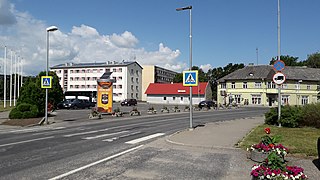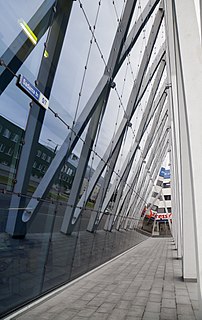
Tallinn is the most populous, primate, and capital city of Estonia. Situated on a bay in north Estonia, on the shore of the Gulf of Finland of the Baltic Sea, Tallinn has a population of 437,811 and administratively lies in the Harju maakond (county). Tallinn is the main financial, industrial, and cultural centre of Estonia. It is located 187 km (116 mi) northwest of the country's second largest city Tartu, however only 80 km (50 mi) south of Helsinki, Finland, also 320 km (200 mi) west of Saint Petersburg, Russia, 300 km (190 mi) north of Riga, Latvia, and 380 km (240 mi) east of Stockholm, Sweden. From the 13th century until the first half of the 20th century, Tallinn was known in most of the world by variants of its other historical name Reval.

Tallinn Airport or Lennart Meri Tallinn Airport is the largest airport in Estonia, which serves as a hub for the national airline Nordica, as well as the secondary hub for AirBaltic, cargo airline Airest and LOT Polish Airlines. It was also the home base of the now defunct national airline Estonian Air. Tallinn Airport is open to both domestic and international flights. It is located 2.7 nautical miles southeast of the centre of Tallinn on the eastern shore of Lake Ülemiste. It was formerly known as Ülemiste Airport.

Narva is a municipality and city in Estonia. It is located in Ida-Viru county, at the eastern extreme point of Estonia, on the west bank of the Narva river which forms the Estonia-Russia international border. With 54,409 inhabitants Narva is Estonia's third largest city after capital Tallinn and Tartu. 46.7% of the city's inhabitants are citizens of Estonia, 36.3% are citizens of the Russian Federation, while 15.3% of the population has undefined citizenship.

Tapa is a town in Tapa Parish, Lääne-Viru County, Estonia. Located at the junction of the country's Tallinn–Narva (west–east) and Tallinn–Tartu–Valga (north–south) railway lines, it is an important centre of transit for freight as well as rail passengers. A home to soldiers since the 1930s, Tapa also plays an important role in training young men and women in the Estonian Defense Forces. The Valgejõgi River passes Tapa on its northeastern side.

AS Eesti Liinirongid, operating as Elron, is a government-owned passenger train operator in Estonia.

Tallink is an Estonian shipping company operating Baltic Sea cruiseferries and ropax ships from Estonia to Finland, Estonia to Sweden, Latvia to Sweden and Finland to Sweden. It is the largest passenger and cargo shipping company in the Baltic Sea region. It owns Silja Line and a part of SeaRail. Tallink Hotels runs four hotels in Tallinn and one in Riga. It is also the co-owner of a taxi company Tallink Takso.

Elektrichka is a Soviet and Eastern bloc commuter (regional) mostly suburban electrical multiple unit passenger train. Elektrichkas are widespread in Russia, Ukraine and other countries of the former Warsaw Pact presenting a socially vital mode of transportation. In 2007, 4085 commuter trains a day were running on the Russian Railways network alone, most of them electric. The first elektrichka ran on July 6, 1926, along the Baku–Sabunchi line in Soviet Azerbaijan. Also urban (intra-city) gorodskaya elektrichkas and airport's aeroexpresses exist in a few cities of Russia, Ukraine, and Belarus.
Eesti Raudtee or EVR is the national railway infrastructure company of Estonia. It owns a network of 691 kilometres (429 mi) of broad gauge railway throughout the country, including the 192 kilometres (119 mi) used by the Elron commuter trains around Tallinn. Its sole shareholder is the Government of Estonia.

The rail transport system in Estonia consists of about 1,200 kilometres (750 mi) of railway lines, of which 900 kilometres (560 mi) are currently in public use. The infrastructure of the railway network is mostly owned by the state and is regulated and surveyed by the Estonian Technical Surveillance Authority.

Oktyabrskaya Railway or October Railway is the subsidiary of RZD, servicing railway lines in the north-west of Russia. It stretches from Moscow's Leningrad Terminal in the south to Murmansk beyond the Arctic Circle in the north. The total length of the lines is over 10,000 km. The headquarters are located in Saint Petersburg.

Rail Baltica is an ongoing greenfield railway infrastructure project to link Finland, Estonia, Latvia and Lithuania with Poland and from there with the European standard gauge rail network. Its purpose is to provide passenger and freight service between participating countries and improve rail connections between Central and Northern Europe, specifically the area in the Southeast of the Baltic sea. Furthermore, it is intended to be a catalyst for building the economic corridor in Northeastern Europe. The project envisages a continuous rail link from Tallinn (Estonia) to Warsaw (Poland). It consists of links via Riga (Latvia), Kaunas and Vilnius (Lithuania) whose total length in the Baltic States is 870 kilometres (540 mi), with 213 kilometres (132 mi) in Estonia, 265 kilometres (165 mi) in Latvia, and 392 kilometres (244 mi) in Lithuania. Rail Baltica is one of the priority projects of the European Union. It is part of the North Sea–Baltic Corridor of the Trans-European Transport Networks (TEN-T).

Baltic Station is the main railway station in Tallinn, Estonia. All local commuter, long-distance and international trains depart from the station.

The history of rail transport in Estonia starts in 1870 when a line was opened connecting Paldiski, Tallinn, Tapa and Narva; the line extending all the way to St. Petersburg in Russia.

Riisipere is a small borough in the Saue Parish, Harju County, Estonia. Prior to the administrative reform of Estonian local governments in March 2017, Riisipere was the administrative center of Nissi Parish. Located on the Ääsmäe-Haapsalu road, its distance from Tallinn is 45 km, from Haapsalu 50 km, Märjamaa 30 km, Rapla 40 km.

The TEP70 main line single unit diesel passenger locomotive, rated at 2,964 kW (3,975 hp), with AC/DC transmission and individual axle traction control, is a railway engine designed to haul passenger trains on the Russian gauge railway network of eastern Europe. As of 2022, it is still in service in Russia, Ukraine, Belarus, Estonia, Latvia, Lithuania, and Kazakhstan. It is the successor to the TEP60, with many design elements is derived from that locomotive; however, the engine was replaced by a four-stroke one. TEP70, especially its experimental batch, incorporated some features of British Rail HS4000, for example, its bogies and some elements of driving control equipment. Later batches of this locomotive incorporated some design features from TEP75 experimental locomotive and predecessor TEP70. Final batches, produced until 2006, also had several important improvements.

The Tallinn–Tapa railway is a 77.8-kilometre (48.3 mi) long double track partly electrified railway line in Estonia, connecting the cities of Tallinn and Tapa.

Voldemar Lender was an Estonian engineer who was the mayor of Tallinn from 1906 to 1913, notably being the first ethnic Estonian to become the mayor of Tallinn.
AS Operail is a railway logistics company located in Tallinn, Estonia. Its sole shareholder is the Government of Estonia.

Ülemiste station is a railway station in the Ülemiste district of Tallinn, the capital city of Estonia. It is approximately 500 metres from Tallinn Airport, to which it has been connected by a tramline since 2017.
















